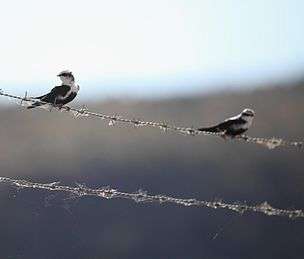White-backed swallow
| White-backed swallow | |
|---|---|
 | |
| Scientific classification | |
| Kingdom: | Animalia |
| Phylum: | Chordata |
| Class: | Aves |
| Order: | Passeriformes |
| Family: | Hirundinidae |
| Genus: | Cheramoeca Cabanis, 1850 |
| Species: | C. leucosterna |
| Binomial name | |
| Cheramoeca leucosterna (Gould, 1841) | |
 White-backed swallow distribution map | |
The white-backed swallow (Cheramoeca leucosterna) is a member of the family Hirundinidae and is endemic to Australia.[1] It is monotypic within the genus Cheramoeca.[2] As with all swallows within the family Hirundinidae, it is characterised by adaptation to aerial feeding. The white-backed swallow can be identified by its white back, surrounded by black wings and tail. The white-backed swallow has a wide distribution, from the southern part of the Australian continent, up to the Tropic of Capricorn. The white-backed swallow prefers grasslands and will create a burrow nest.

Description
.jpg)
An adult white-backed swallows averages 15 cm long, similar in size to other swallows found within Australia.[3] The adult has a mottled grey cap above white eyebrows and a grey eye stripe across the nape of the neck. The back and most of the breast is white. The belly, wings and tail are black.
The white-backed swallow has a deeply forked tail, with curved and pointed wings. The short bill is black; the legs and feet are grey. They have a slender, streamlined body. Their eyes consist of a prominent, dark iris. The sexes have similar colouring but during adolescence the white-backed swallow has duller colours.[4]
John Gould first described the white-backed swallow in 1841 and included it in his publication “The Birds of Australia”. The white-backed swallow is also sometimes referred to as “Black-and-white Swallow", "White-breasted Swallow", "White-capped Swallow.". A taxonomic synonym for Cheramoeca leucosterna is Cheramoeca leucosternus.[5]
Habitat & Range
White-backed Swallows are endemic to Australia and have a wide population distribution on the continent. They can be found from the southern latitudes of Australia and their range extends to the Tropic of Capricorn. Occasionally, after inland rainfall, white-backed swallows can extend their range to encompass the entire southern portion of Australia including the desert regions. White-backed Swallows prefer open country, above open grassland and low shrubs. During the breeding season, they have a strong preference for habitats around creek beds.[6]
There is no population count, but the species is reported to be common.[7] Due to range expansion from land clearance and mining, the population is estimated to be increasing. Due to the large range and increasing population, the white-backed swallow is categorised as least concern.

Behaviour
White-backed Swallows are insectivorous and feed in-flight on insects, like all known swallows. The composition of its diet varies by geographic region and with the time of year. The white-backed swallow typically nests by digging a horizontal tunnel into a vertical dirt cliff.[8] Predation of swallows nests is known to occur, typically from foxes and cats.[9]
References
- 1 2 BirdLife International (2012). "Cheramoeca leucosterna". IUCN Red List of Threatened Species. Version 2013.2. International Union for Conservation of Nature. Retrieved 26 November 2013.
- ↑ "ITIS Report: Cheramoeca". Integrated Taxonomic Information System. Retrieved 22 July 2012.
- ↑ Christidis, Les; Boles, Walter (2008-01-01). Systematics and Taxonomy of Australian Birds. Csiro Publishing. ISBN 9780643065116.
- ↑ "White-backed Swallow (Cheramoeca leucosterna)". www.hbw.com. Retrieved 2015-10-14.
- ↑ Christidis, Les; Boles, Walter (2008-01-01). Systematics and Taxonomy of Australian Birds. Csiro Publishing. ISBN 9780643065116.
- ↑ Morcombe, Michael (2004-04-19). Field Guide to Australian Birds.
- ↑ Turner, Rose, A, C (1989). Swallows and martins of the world. Christopher Helm, London.
- ↑ "White-backed Swallow (Cheramoeca leucosterna) - BirdLife species factsheet". www.birdlife.org. Retrieved 2015-10-14.
- ↑ Read, John; Bowen, Zoë (2001-01-01). "Population dynamics, diet and aspects of the biology of feral cats and foxes in arid South Australia". Wildlife Research 28 (2): 195–203.
| ||||||||||||||||||||||||||||||||||||||||||||||||||||||||||||||||||||||||||||||||||||||||||||||||||||||||||
[[File:The birds of Australia (17065696432).jpg|The birds of Australia (17065696432)]]
